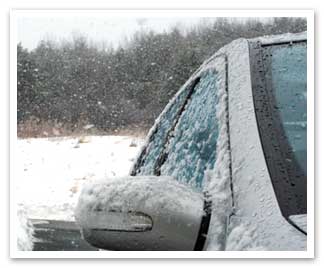
It’s officially winter. If you’re in a part of the country where winter comes along with snow and ice, you know driving becomes a bit trickier this time of year. Experienced drivers know how to adjust their driving to account for the weather conditions. Teen drivers, or other novice (new) drivers, however, usually need more time to practice before they feel comfortable driving in the winter. If you have a teen driver at home, and you live in an area where winter weather presents some driving challenges, this blog post is for you! Here are 5 ways to help get your teen ready to tackle winter driving.
1. Answer any questions your teen may have.

Sometimes it’s difficult to think of questions to ask in the moment. Explain to your teen that you’re going to be working on winter driving together. Ask them to make a list of at least five questions they have about driving in the winter. Make sure they write down their questions so you can have a physical list to look at together. Give your teen a few days to work on their list before deciding on a time to work through the list together. Once their list is complete, read through the list together and answer the questions as best you can. If you’re unsure about some of their questions, you can look up the answer together. Some questions may be best answered through demonstration, which is #4 below.
2. Review safe driving practices.
When you’ve answered your teen’s questions, it’s time to talk about driving in the winter. As experienced drivers, we know how to adjust our driving to account for snow and ice. Here are some winter driving tips to share with your teen:
- Wet, snowy, or icy roads usually require you to drive below the speed limit in order to stay safe. Even vehicles with four wheel drive should slow down in snowy weather.
- Increase your following distance behind other vehicles. For novice drivers, a safe following distance is 3-4 seconds. In winter weather, it’s a good idea to double your normal following distance. Leave plenty of space between your vehicle and snow plows.
- Slow down when crossing bridges, because water on bridges freezes faster and thaws slower than water on the regular roadway. Black ice is difficult to see and avoid, so it’s best to drive slowly and safely.
- Make sure you are constantly scanning the road ahead for danger spots. Watch for drifting snow.
- Take extra precautions when making turns. If you turn too quickly, it’s easy to lose traction and skid.
- If you do start to skid in the snow, take your foot off the gas and do not slam on the brakes. Steer the vehicle in the direction you want to go. Prepare to counter steer and then straighten the wheels. Apply the brakes lightly once you have control of the vehicle.
3. Make sure their vehicle is ready for winter weather.
Whether your teen has their own vehicle or they drive a family vehicle, make it a priority to involve your teen in the process of getting your family’s vehicles ready for winter. This includes getting the vehicle serviced, checking the battery, tires, and windshield wipers, and packing an emergency kit. Check out our blog post on this topic for a more detailed list of how to get your vehicle ready for winter weather!
4. Supervise your teen practicing driving in winter weather.

Just like normal driving, winter driving takes practice. The best option is an empty, untreated parking lot where your teen can get a feel for how their vehicle reacts to snowy roads. This way, your teen can practice how to adjust their driving and how to control their vehicle during skids or fishtailing in a safe environment.
5. Make sure they know when it’s safer to stay home.
Sometimes, the best option is to just stay home during a bad snow storm. Show your teen how to check the weather forecasts and to account for what time they will be on the road. Even if it’s clear when they leave for school in the morning, there could be a big storm in the afternoon that leaves them stranded. While they need to be able to drive safely in all types of weather, they also need to understand that their safety is more important than anything else.
Driving in the winter can be intimidating. That’s why it’s important to have these conversations with teen drivers. We hope these tips help you and your teen driver this winter! If your teen needs to complete a driver education course as a licensing requirement, or just to brush up on their driving knowledge, please visit our website. We offer fun, engaging, and informative driver education courses your student can complete online. Click here to see if we offer a course in your state!
It’s officially winter. If you’re in a part of the country where winter comes along with snow and ice, you know driving becomes a bit trickier this time of year. Experienced drivers know how to adjust their driving to account for the weather conditions. Teen drivers, or other novice (new) drivers, however, usually need more time to practice before they feel comfortable driving in the winter. If you have a teen driver at home, and you live in an area where winter weather presents some driving challenges, this blog post is for you! Here are 5 ways to help get your teen ready to tackle winter driving.